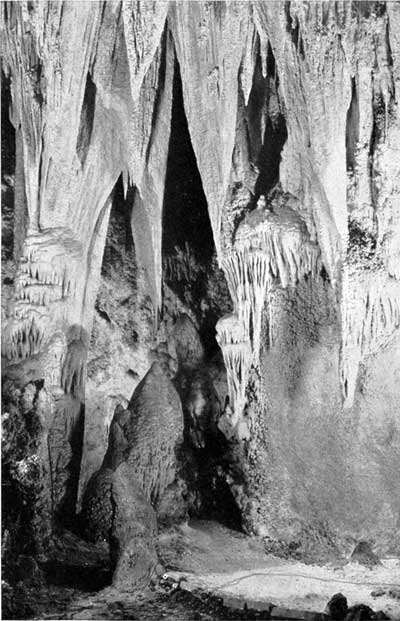![]()
MENU
![]() Carlsbad Caverns
Carlsbad Caverns
|
Glimpses of Our National Parks |
 XXII
XXII

THE CARLSBAD CAVERNS NATIONAL PARK
NEW MEXICO
Special Characteristic: Series of Connected Caverns, Believed to be the Largest in the World, With Magnificent Limestone Decorations
 Queen's Chamber—Carlsbad Caverns National Park |
AMONG the superb areas included in the national park system of the United States is a series of connected caverns of unusual magnificence and extent called the Carlsbad Caverns. They are located in southeastern New Mexico, in the rugged foothills of the Guadalupe Mountains. The region is picturesque semidesert country, and its unusual cactus vegetation is as strange and interesting to many visitors as are the caverns themselves.
Carlsbad Caverns, like most caves, is a series of openings in a massive limestone which were made by percolating ground water. The Carlsbad limestone in which these caverns were formed was laid down originally in a sea of muddy water some 200 million years ago.
After the great series of chambers forming the main portions of the caverns were formed, nature took up the task of decorating them with a myriad of beautifully sculptured effects in the form of stalagmites, stalactites, more irregular spiral forms known as helectites, enormous columns, curtains seemingly of alabaster, and other limestone ornamentations.
The immensity of the large rooms, the beauty of form, and the impenetrable stillness leave an indelible impression upon all who venture into this fairyland.
The most impressive portion of the Carlsbad Caverns is the Big Room, an enormous chamber a mile and a half from the entrance. It is nearly 4,000 feet long, with a maximum width of 625 feet. At one place the ceiling rises to a height of 350 feet. In this room the limestone formations are superbly beautiful and of an infinite variety of sizes and shapes. The stalactites vary from almost needlelike proportions to huge chandeliers, and the stalagmites are equally varied, though of different contours. One group of unusually tall and graceful stalagmites resembles the totem poles of the Alaskan Indians and others are like snow-banked forests.
The most outstanding formation in this room is the Giant Dome, 62 feet high, 16 feet in diameter, with a striking resemblance to the Leaning Tower of Pisa.
Nearby are the fountain basins, lined with masses of crystalline onyx marble, which remind one of the hot-springs formations of Yellowstone National Park. The basins are decorated at the rim with crusts of onyx resembling lily pads, formed at the surface of the water in much the same way that ice forms around the edge of a pool.
EXTENT OF THE CAVERNS AND OF PARK
The size of the Carlsbad Caverns has not yet been determined. Already many miles of passages and chambers have been explored, and each year further mileage is conquered. How far the caverns extend under the Guadalupe Mountains can only be conjectured.
At the present time the cavern has three main levels, and there may be others not yet discovered. The first is at 750 feet, to which visitors are conducted. Below it is another vast subterranean apartment at 900 feet, and below that still another at 1,320 feet. None of these levels has been completely explored, nor is it the desire of the National Park Service to make further explorations until the present known areas are more fully developed.
EXPLORATION OF CAVERNS
The first white man known to have explored the caverns is Jim White, a cowboy of the locality. This was in 1901. Seeing a dark, moving column issuing from the region, he investigated and found a natural opening in the earth which led down to the caverns. The dark, smokelike column proved to be alive, a moving stream of bats emerging from their day-long siesta in the darkness of the caves.
With a young Mexican boy as his only companion, Jim White made extensive explorations of the caverns, insuring success in his return by leaving behind him a trail of smudge marks and strings. Many long stretches of string still remain in the less-visited portions of the caverns today, a monument to the intrepid courage of the young cowboy whose love of adventure made him the pioneer explorer of the world's greatest caverns.
After exploring Carlsbad Caverns, Jim White never missed an opportunity to take visitors into his find and share its beauties with them. Their reports of the size and magnificence of the underground chambers led to examinations of the caverns by representatives of the Federal Government and finally resulted in the reservation of the area for public use and enjoyment.
THE BAT SPECTACLE
The bat spectacle which first claimed the attention of Jim White and led to the discovery of the caverns is now one of the great attractions of the Carlsbad Caverns National Park.
Each evening at dusk, except during the winter period of hibernation, millions of bats come forth from a cavern 180 feet below the surface, flying in a spiral through the great entrance arch, and streaming off over the rim in a southerly direction, later to separate into flocks which disappear in the distance for a night's foraging. Beginning about sunset, the flight outward lasts for about 3 hours. The bats return before the following dawn.
It has been estimated that 3,000,000 bats during one night's foray consume a little over 11-1/2 tons of night-flying insects, such as various kinds of moths, beetles, flies, and mosquitoes.
During the day the bats hang by their legs, heads downward, in great clusters high on the walls and ceilings of their particular portion of the cavern. From October until March they hibernate, hanging in this position and seeming almost lifeless.
The portion of the cavern occupied by the bats is a long corridor extending a quarter of a mile eastward from the main entrance, and is not open to visitors.
|
|
Last Modified: Fri, Sep 1 2000 07:08:48 pm PDT
glimpses1/glimpses22.htm

 Top
Top